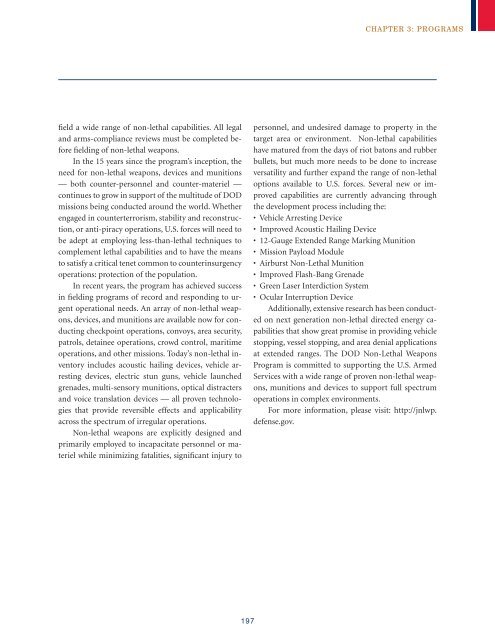USMC Concepts & Programs 2013 - Defense Innovation Marketplace
USMC Concepts & Programs 2013 - Defense Innovation Marketplace
USMC Concepts & Programs 2013 - Defense Innovation Marketplace
You also want an ePaper? Increase the reach of your titles
YUMPU automatically turns print PDFs into web optimized ePapers that Google loves.
chapter 3: programs<br />
field a wide range of non-lethal capabilities. All legal<br />
and arms-compliance reviews must be completed before<br />
fielding of non-lethal weapons.<br />
In the 15 years since the program’s inception, the<br />
need for non-lethal weapons, devices and munitions<br />
— both counter-personnel and counter-materiel —<br />
continues to grow in support of the multitude of DOD<br />
missions being conducted around the world. Whether<br />
engaged in counterterrorism, stability and reconstruction,<br />
or anti-piracy operations, U.S. forces will need to<br />
be adept at employing less-than-lethal techniques to<br />
complement lethal capabilities and to have the means<br />
to satisfy a critical tenet common to counterinsurgency<br />
operations: protection of the population.<br />
In recent years, the program has achieved success<br />
in fielding programs of record and responding to urgent<br />
operational needs. An array of non-lethal weapons,<br />
devices, and munitions are available now for conducting<br />
checkpoint operations, convoys, area security,<br />
patrols, detainee operations, crowd control, maritime<br />
operations, and other missions. Today’s non-lethal inventory<br />
includes acoustic hailing devices, vehicle arresting<br />
devices, electric stun guns, vehicle launched<br />
grenades, multi-sensory munitions, optical distracters<br />
and voice translation devices — all proven technologies<br />
that provide reversible effects and applicability<br />
across the spectrum of irregular operations.<br />
Non-lethal weapons are explicitly designed and<br />
primarily employed to incapacitate personnel or materiel<br />
while minimizing fatalities, significant injury to<br />
personnel, and undesired damage to property in the<br />
target area or environment. Non-lethal capabilities<br />
have matured from the days of riot batons and rubber<br />
bullets, but much more needs to be done to increase<br />
versatility and further expand the range of non-lethal<br />
options available to U.S. forces. Several new or improved<br />
capabilities are currently advancing through<br />
the development process including the:<br />
• Vehicle Arresting Device<br />
• Improved Acoustic Hailing Device<br />
• 12-Gauge Extended Range Marking Munition<br />
• Mission Payload Module<br />
• Airburst Non-Lethal Munition<br />
• Improved Flash-Bang Grenade<br />
• Green Laser Interdiction System<br />
• Ocular Interruption Device<br />
Additionally, extensive research has been conducted<br />
on next generation non-lethal directed energy capabilities<br />
that show great promise in providing vehicle<br />
stopping, vessel stopping, and area denial applications<br />
at extended ranges. The DOD Non-Lethal Weapons<br />
Program is committed to supporting the U.S. Armed<br />
Services with a wide range of proven non-lethal weapons,<br />
munitions and devices to support full spectrum<br />
operations in complex environments.<br />
For more information, please visit: http://jnlwp.<br />
defense.gov.<br />
197

















